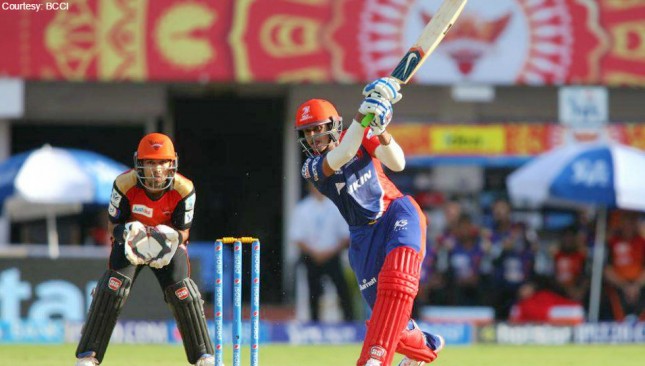
One of the foremost things that strike you when Shreyas Iyer takes guard is the unbelievable amount of confidence he exudes from his stance. There’s an obvious aura of nonchalance, a silent insouciance that defines his batting. He is unrattled by big names, undeterred by adversities, unconcerned with the odds as they stack against him.
Known for his aggression and love for big scores, Iyer impressed all and sundry during his stint with the Delhi Daredevils last season. The innate confidence that had once urged him to call up his mother and announce that he would score a century the next day before actually going on to do so, did not escape the likes of JP Duminy during the IPL.
As a youngster learning the preliminary nuances of maturity, Iyer is as unabashed off the field as he is on it. Speaking about breaking into the Indian team after emerging as the highest run-getter in the Ranji Trophy 2015-16, an excited Iyer remarked, “I think they should get me now into the team,” only to correct himself quickly by adding “it is not my job to think about it. My aim is to keep performing well, keep doing my job; let the selectors do their jobs. I will let the bat do the talking rather than me speaking about this topic.”
THE CALL THAT NEVER CAME
His Ranji figures are imposing, akin to the domination he enforces while at the crease. After a scintillating debut season, Iyer amassed 1,321 runs in the 2015-16 Ranji Trophy at an average of 73.39 with 7 fifties and 4 centuries, including a match-winning 117 in the final against Saurashtra. He became only the second player to score 1,300 in a single Ranji competition, but eventually fell short of VVS Laxman’s all-time record by 95 runs.
After accumulating more than 2,300 domestic runs over the course of two seasons, hopes of a national call-up are neither misplaced nor overtly optimistic. But for the 21-year old, the call never came. Not yet, anyway. Did the selectors assume that the exponent of breathtaking pulls was not mature enough to face the best in the world on the biggest stage? Granted, toying with the Jaydev Unadkats is no match to standing up against the Mitchell Starcs of the world, but if not the nous, Iyer does have the resolve and determination to make a case for himself in international cricket.

The fact that Iyer’s rise to prominence coincided impeccably with Shikhar Dhawan’s barren run made the selectors’ reluctance all the more confounding. At a time when the opener debate encircled Indian cricket with Dhawan’s repeated failures being the Achilles’ heel at the top, Iyer’s consistency demanded acknowledgement and global recognition.
DHAWAN’S FALL AND IYER’S ASCENT
The difference between the two couldn’t have been clearer. While doubt and hesitation guided Dhawan as he nudged and poked at deliveries, the right-hander’s strokeplay brimmed with confidence, self-belief and conviction. Iyer is not a natural opener but rather one by design, it being a position he thrived in for the Daredevils.
Dhawan lacked assurance, Iyer was full of it. The latter maneuvered the gaps, struck boundaries at will and demolished attacks day in and day out, while the southpaw was frequently found flailing at deliveries before gifting away his wicket with impetuous strokes borne out of frustration.
It was, therefore, unfathomable when Dhawan’s spot refused to open up. As astonishing as it may sound, the selectors persisted with him despite his obvious shortcomings while the in-form Iyer was snubbed for India’s campaign in Australia, as the Asia Cup and even the World T20.
For any aspiring international cricketer, the repeated cold shoulder treatment was bound to get frustrating and demoralising after a point. Although Iyer maintained that “maybe it was better to gain experience for another year, then get in the team”, his dejection was conspicuous in its apparent absence. It was only a matter of time before the disappointment began to eat away at his form.
FRUSTRATION BEGINNING TO SEEP INTO HIS BATTING
So when the IPL arrived in April, the dissatisfaction, quite understandably, began to affect his cricket. Gone was the Midas touch; Iyer now suddenly found himself tossed into ordinariness – among the same group of predictable talent that he had once surpassed through hard work and dedication. Forget belligerence, forget dominating the opposition, he was now vulnerable to getting dismissed early on.
How the world changes in sport. Shreyas Iyer couldn't do a thing wrong last year,can't buy a run this year. But good players emerge stronger
— Harsha Bhogle (@bhogleharsha) April 30, 2016
Was it the pressure of not being provided with the opportunity to reap the rewards of his hard work? Had he lost the zeal to perform and stand out amongst the plethora of talent? Has he given up knocking on the selectors’ door?
Probably not, Iyer is too cool a cat for that. He may struggle to stay afloat in the ocean of mediocrity right now, and may lose his spot in the Daredevils team sheet temporarily, but it must be only a matter of time and patience before his flair flows back. When he does so remains the question, for the lingering fear that it might be too late is too realistic to be shrugged off.
It is this point that persuades one to believe that India indeed lost the plot somewhat by not tapping into his talent while it was yielding the goods. Not only did his omission from the scheme of things hurt the national team, it also evoked the uncertainty that hard work and success may not always fetch the returns one expects. Only time can reveal when Iyer will return to form and construct a compelling argument once again for the elusive national cap. And as interesting will be whether that argument corresponds with a vacancy in the Indian line-up.
Timing, as they say, is everything in cricket.
[interaction id=”572f7f005dc790645b06b313″]